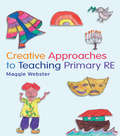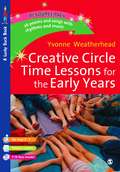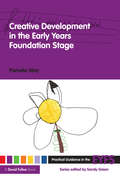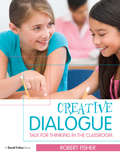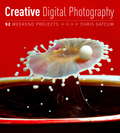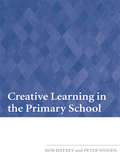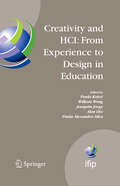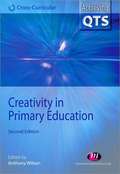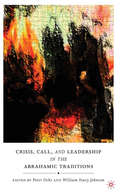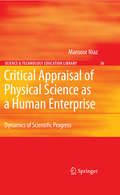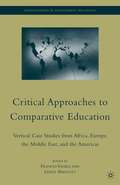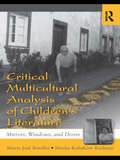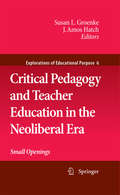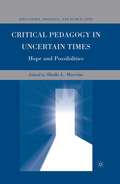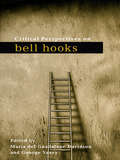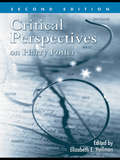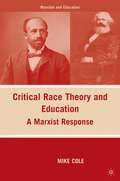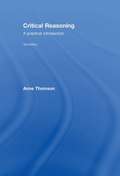- Table View
- List View
Creative Approaches to Teaching Primary RE
by Maggie WebsterAs an increasingly significant aspect of primary teaching, Creative Approaches to Teaching Primary RE is the essential companion to help bring creativity to life in the classroom. The text begins with a discussion of creative education and the value of Religious Education, moving on to reflect on the cross-curricular nature of the subject, exploring ways of introducing creativity to the classroom, through the medium of Religious Education. Each chapter provides ideas and activities demonstrating how pedagogy and theory can be applied in practice within a school setting. The inclusion of case studies will help you consider how to develop creative approaches in all curriculum areas. This book invites you to ask questions such as:· What is Creative Education?· Why should RE be included in the ever-changing curriculum?· How can I use Religious Education to generate a more creative environment in the classroom?
Creative Approaches to Teaching Primary RE
by Maggie WebsterAs an increasingly significant aspect of primary teaching, Creative Approaches to Teaching Primary RE is the essential companion to help bring creativity to life in the classroom. The text begins with a discussion of creative education and the value of Religious Education, moving on to reflect on the cross-curricular nature of the subject, exploring ways of introducing creativity to the classroom, through the medium of Religious Education. Each chapter provides ideas and activities demonstrating how pedagogy and theory can be applied in practice within a school setting. The inclusion of case studies will help you consider how to develop creative approaches in all curriculum areas. This book invites you to ask questions such as:· What is Creative Education?· Why should RE be included in the ever-changing curriculum?· How can I use Religious Education to generate a more creative environment in the classroom?
Creative Circle Time Lessons for the Early Years
by Yvonne WeatherheadIncludes CD-rom! This creative book uses music, song, poetry and a host of practical ideas to engage children in Circle Time Activities. The publication stems from Yvonne's own work in schools where 26 alphabetical themes have been centralised around a lovable bear character. There are four strands in the book which are linked to the Social Skills curriculum. - Self esteem - Relationships - Communications - Spiritual and Moral Development These strands are developed through the 26 themes from 'Adorable' bear to 'Zig Zag' bear with a weekly introduction of a new rhythm to accompany the poem. For each theme there are comprehensive notes for teachers with lots of ideas on the content of each theme. The DVD- ROM contains all 26 poems and songs, recited or sung by the children. The DVD-Rom also includes printable posters and positive thought sheets. As an experienced teacher Yvonne offers not only a comprehensive practical resource that all teachers will find useful and time saving, but she also provides links to Citizenship, planning sheets for PSHE, lesson objectives and full lesson notes, providing all the support busy teachers need. A very exciting practical resource, easy to use and built on a very solid foundation of many years of expertise and practice. Visit the author's website here and you can contact her to book INSET training
Creative Development in the Early Years Foundation Stage (Practical Guidance in the EYFS)
by Pamela MayThe Practical Guidance in the Early Years Foundation Stage series will assist practitioners in the smooth and successful implementation of the Early Years Foundation Stage. Each book gives clear and detailed explanations of each aspect of Learning and Development and encourages readers to consider each area within its broadest context to expand and develop their own knowledge and good practice. Practical ideas and activities for all age groups are offered along with a wealth of expertise of how elements from the practice guidance can be implemented within all early years settings. The books include suggestions for the innovative use of everyday ressources, popular books and stories. The clear and practical information in this book will help practitioners in supporting and developing the natural curiosity of children, helping them explore and express their own ideas through a variety of activities including music art and dance. The author explores the balance between the necessary freedoms of choice that creativity requires and the control which thoughtful practitioners must exert and offers ideas for building children's imaginations through play.
Creative Development in the Early Years Foundation Stage (Practical Guidance in the EYFS)
by Pamela MayThe Practical Guidance in the Early Years Foundation Stage series will assist practitioners in the smooth and successful implementation of the Early Years Foundation Stage. Each book gives clear and detailed explanations of each aspect of Learning and Development and encourages readers to consider each area within its broadest context to expand and develop their own knowledge and good practice. Practical ideas and activities for all age groups are offered along with a wealth of expertise of how elements from the practice guidance can be implemented within all early years settings. The books include suggestions for the innovative use of everyday ressources, popular books and stories. The clear and practical information in this book will help practitioners in supporting and developing the natural curiosity of children, helping them explore and express their own ideas through a variety of activities including music art and dance. The author explores the balance between the necessary freedoms of choice that creativity requires and the control which thoughtful practitioners must exert and offers ideas for building children's imaginations through play.
Creative Dialogue: Talk for Thinking in the Classroom
by Robert FisherCreative Dialogue is an essential guide to dialogic learning for every trainee and practising teacher. It presents practical ways of teaching children to be more thoughtful and creative, and to learn more effectively through speaking and listening in school and at home. The book includes: practical ways to develop dialogic learning across the curriculum a guide to developing talk for thinking in the classroom more than 100 activities for stimulating talk with children of all ages and abilities advice on using dialogue to support assessment for learning ideas for developing listening skills and concentration. Written by a leading expert in teaching thinking, Creative Dialogue is essential reading for all who wish to understand and develop dialogic learning in education today.
Creative Dialogue: Talk for Thinking in the Classroom
by Robert FisherCreative Dialogue is an essential guide to dialogic learning for every trainee and practising teacher. It presents practical ways of teaching children to be more thoughtful and creative, and to learn more effectively through speaking and listening in school and at home. The book includes: practical ways to develop dialogic learning across the curriculum a guide to developing talk for thinking in the classroom more than 100 activities for stimulating talk with children of all ages and abilities advice on using dialogue to support assessment for learning ideas for developing listening skills and concentration. Written by a leading expert in teaching thinking, Creative Dialogue is essential reading for all who wish to understand and develop dialogic learning in education today.
Creative Digital Photography: 52 Weekend Projects
by Chris GatcumDo you wish you could take better, more exciting photos? Now you can, with 'Creative Digital Photography: 52 Weekend Projects'. Through this collection of handy weekend projects you will get expert insights and clear step-by-step instructions across the field of photography so you too can learn diverse techniques for taking and processing photos, and discover how to make useful equipment for minimal cost. Whether you're making a simple diffuser for your flash, setting up a time-lapse shoot or simply taking a chance and tossing your camera in the air, you will develop your skills, making your own stunning images and standing out from the crowd. Designed for photographers of all levels with the projects graded in complexity.
Creative Learning in the Primary School
by Bob Jeffrey Peter WoodsCreative Learning in the Primary School uses ethnographic research to consider the main features of creative teaching and learning within the context of contemporary policy reforms. In particular, the authors are interested in the clash between two oppositional discourses - creativity and performativity - and how they are resolved in creative teacher practice. The book complements previous work by these authors on creative teaching by giving more consideration to creative learning. The first section of the book explores the nature of creative teaching and learning by examining four key features: relevance, control, ownership and innovation. The authors devote a chapter to each of these aspects, outlining their properties and illustrating them with a wide range of examples, mainly from recent practice in primary schools. The second section presents some instructive examples of schools promoting creative learning, and how creative primary schools have responded to the policy reforms of recent years. The chapters focus specifically on: how pupils act as a powerful resource for creative learning for each other and for their teachers; how teachers have appropriated the reforms to enhance their creativity; and how one school has moved over a period of ten years from heavy constraint to high creativity. The blend of analysis, case-study material and implications for practice will make this book attractive to primary teachers, school managers, policy makers, teacher educators and researchers.
Creative Learning in the Primary School
by Bob Jeffrey Peter WoodsCreative Learning in the Primary School uses ethnographic research to consider the main features of creative teaching and learning within the context of contemporary policy reforms. In particular, the authors are interested in the clash between two oppositional discourses - creativity and performativity - and how they are resolved in creative teacher practice. The book complements previous work by these authors on creative teaching by giving more consideration to creative learning. The first section of the book explores the nature of creative teaching and learning by examining four key features: relevance, control, ownership and innovation. The authors devote a chapter to each of these aspects, outlining their properties and illustrating them with a wide range of examples, mainly from recent practice in primary schools. The second section presents some instructive examples of schools promoting creative learning, and how creative primary schools have responded to the policy reforms of recent years. The chapters focus specifically on: how pupils act as a powerful resource for creative learning for each other and for their teachers; how teachers have appropriated the reforms to enhance their creativity; and how one school has moved over a period of ten years from heavy constraint to high creativity. The blend of analysis, case-study material and implications for practice will make this book attractive to primary teachers, school managers, policy makers, teacher educators and researchers.
Creativity and HCI: Selected Contributions from HCIEd 2007, March 29-30, 2007, Aveiro, Portugal (IFIP Advances in Information and Communication Technology #289)
by Alan Dix Joaquim Jorge Paula Alexandra Silva William Wong Paula KotzéInternational Federation for Information Processing The IFIP series publishes state-of-the-art results in the sciences and technologies of information and communication. The scope of the series includes: foundations of computer science; software theory and practice; education; computer applications in technology; communication systems; systems modeling and optimization; information systems; computers and society; computer systems technology; security and protection in information processing systems; artificial intelligence; and human-computer interaction. Proceedings and post-proceedings of refereed international conferences in computer science and interdisciplinary fields are featured. These results often precede journal publication and represent the most current research. The principal aim of the IFIP series is to encourage education and the dissemination and exchange of information about all aspects of computing. For more information about the 300 other books in the IFIP series, please visit www.springer.com.
Creativity in Primary Education
by Anthony WilsonA sound understanding of the role primary creativity plays in learning and teaching will help trainee teachers become creative practitioners and develop creativity in their pupils. The second edition of this popular text retains key material from the previous book, but it has been substantially updated and revised to include six new chapters which explore creativity in both a subject specific context as well as the broader issues of creativity in SMSC and the Foundation Stage. The book is linked throughout to the Standards for the award of QTS and also considers important government agendas such as Every Child Matters.
Crisis, Call, and Leadership in the Abrahamic Traditions
by P. Ochs W. JohnsonSixteen Muslim, Jewish, and Christian scholars sought to answer one question: 'Do our three scriptures unite or divide us?' Each essay examines scriptural sources as read in the classical and medieval traditions, addressing issues including how each tradition addresses the 'other' within its tradition and without, and the challenges of modernity.
Critical Appraisal of Physical Science as a Human Enterprise: Dynamics of Scientific Progress (Contemporary Trends and Issues in Science Education #36)
by Mansoor NiazIt is generally believed that doing science means accumulating empirical data with no or little reference to the interpretation of the data based on the scientist’s th- retical framework or presuppositions. Holton (1969a) has deplored the widely accepted myth (experimenticism) according to which progress in science is presented as the inexorable result of the pursuit of logically sound conclusions from un- biguous experimental data. Surprisingly, some of the leading scientists themselves (Millikan is a good example) have contributed to perpetuate the myth with respect to modern science being essentially empirical, that is carefully tested experim- tal facts (free of a priori conceptions), leading to inductive generalizations. Based on the existing knowledge in a field of research a scientist formulates the guiding assumptions (Laudan et al. , 1988), presuppositions (Holton, 1978, 1998) and “hard core” (Lakatos, 1970) of the research program that constitutes the imperative of presuppositions, which is not abandoned in the face of anomalous data. Laudan and his group consider the following paraphrase of Kant by Lakatos as an important guideline: philosophy of science without history of science is empty. Starting in the 1960s, this “historical school” has attempted to redraw and replace the positivist or logical empiricist image of science that dominated for the first half of the twentieth century. Among other aspects, one that looms large in these studies is that of “guiding assumptions” and has considerable implications for the main thesis of this monograph (Chapter 2).
Critical Approaches to Comparative Education: Vertical Case Studies from Africa, Europe, the Middle East, and the Americas (International and Development Education)
by F. Vavrus L. BartlettThis book unites a dynamic group of scholars who examine linkages among local, national, and international levels of educational policy and practice. Utilizing multi-sited, ethnographic approaches, the essays explore vertical interactions across diverse levels of policy and practice while prompting horizontal comparisons across twelve sites in Africa, Europe, the Middle East, and the Americas. The vertical case studies focus on a range of topics, including participatory development, the politics of culture and language, neoliberal educational reforms, and education in post-conflict settings. Editors Vavrus and Bartlett contribute to comparative theory and practice by demonstrating the advantages of thinking vertically.
Critical Multicultural Analysis of Children's Literature: Mirrors, Windows, and Doors (Language, Culture, and Teaching)
by Maria José Botelho Masha Kabakow Rudman"Children’s literature is a contested terrain, as is multicultural education. Taken together, they pose a formidable challenge to both classroom teachers and academics…. Rather than deny the inherent conflicts and tensions in the field, in Critical Multicultural Analysis of Children’s Literature: Mirrors, Windows, and Doors, Maria José Botelho and Masha Kabakow Rudman confront, deconstruct, and reconstruct these terrains by proposing a reframing of the field…. Surely all of us – children, teachers, and academics – can benefit from this more expansive understanding of what it means to read books." Sonia Nieto, From the Foreword Critical multicultural analysis provides a philosophical shift for teaching literature, constructing curriculum, and taking up issues of diversity and social justice. It problematizes children’s literature, offers a way of reading power, explores the complex web of sociopolitical relations, and deconstructs taken-for-granted assumptions about language, meaning, reading, and literature: it is literary study as sociopolitical change. Bringing a critical lens to the study of multiculturalism in children’s literature, this book prepares teachers, teacher educators, and researchers of children’s literature to analyze the ideological dimensions of reading and studying literature. Each chapter includes recommendations for classroom application, classroom research, and further reading. Helpful end-of-book appendixes include a list of children’s book awards, lists of publishers, diagrams of the power continuum and the theoretical framework of critical multicultural analysis, and lists of selected children’s literature journals and online resources.
Critical Multicultural Analysis of Children's Literature: Mirrors, Windows, and Doors (Language, Culture, and Teaching)
by Maria José Botelho Masha Kabakow Rudman"Children’s literature is a contested terrain, as is multicultural education. Taken together, they pose a formidable challenge to both classroom teachers and academics…. Rather than deny the inherent conflicts and tensions in the field, in Critical Multicultural Analysis of Children’s Literature: Mirrors, Windows, and Doors, Maria José Botelho and Masha Kabakow Rudman confront, deconstruct, and reconstruct these terrains by proposing a reframing of the field…. Surely all of us – children, teachers, and academics – can benefit from this more expansive understanding of what it means to read books." Sonia Nieto, From the Foreword Critical multicultural analysis provides a philosophical shift for teaching literature, constructing curriculum, and taking up issues of diversity and social justice. It problematizes children’s literature, offers a way of reading power, explores the complex web of sociopolitical relations, and deconstructs taken-for-granted assumptions about language, meaning, reading, and literature: it is literary study as sociopolitical change. Bringing a critical lens to the study of multiculturalism in children’s literature, this book prepares teachers, teacher educators, and researchers of children’s literature to analyze the ideological dimensions of reading and studying literature. Each chapter includes recommendations for classroom application, classroom research, and further reading. Helpful end-of-book appendixes include a list of children’s book awards, lists of publishers, diagrams of the power continuum and the theoretical framework of critical multicultural analysis, and lists of selected children’s literature journals and online resources.
Critical Pedagogy and Teacher Education in the Neoliberal Era: Small Openings (Explorations of Educational Purpose #6)
by Susan L. Groenke J. Amos HatchSusan L. Groenke and J. Amos Hatch It does not feel safe to be critical in university-based teacher education programs right now, especially if you are junior faculty. In the neoliberal era, critical teacher education research gets less and less funding, and professors can be denied tenure or lose their jobs for speaking out against the status quo. Also, we know that the pedagogies critical teacher educators espouse can get beginning K–12 teachers fired or shuffled around, especially if their students’ test scores are low. This, paired with the resistance many of the future teachers who come through our programs—predominantly White, middle-class, and happy with the current state of affairs—show toward critical pedagogy, makes it seem a whole lot easier, less risky, even smart not to “do” critical pedagogy at all. Why bother? We believe this book shows we have lots of reasons to “bother” with critical pe- gogy in teacher education, as current educational policies and the neoliberal discourses that vie for the identities of our own local contexts increasingly do not have education for the public good in mind. This book shows teacher educators taking risks, seeking out what political theorist James Scott has called the “small openings” for resistance in the contexts that mark teacher education in the early twenty-first century.
Critical Pedagogy in Uncertain Times: Hope and Possibilities (Education, Politics and Public Life)
by Sheila L. MacrineThis book brings together the most important figures in the evolution of Critical Pedagogy to provide comprehensive analyses of issues related to the struggle against the forces of neoliberalism and the imperial-induced privatization, not just in education, but in all of social life through the radical democratizing forces of critical pedagogy.
Critical Perspectives on bell hooks (Critical Social Thought)
by Maria Del Guadalupe Davidson George YancyAlthough bell hooks has long challenged the dominant paradigms of race, class, and gender, there has never been a comprehensive book critically reflecting upon this seminal scholar’s body of work. Her written works aim to transgress and disrupt those codes that exclude others as intellectually mediocre, and hooks’ challenge to various hegemonic practices has heavily influenced scholars in numerous areas of inquiry. This important resource thematically examines hooks’ works across various disciplinary divides, including her critique on educational theory and practice, theorization of racial construction, dynamics of gender, and spirituality and love as correctives in postmodern life. Ultimately, this book offers a fresh perspective for scholars and students wanting to engage in the prominent work of bell hooks, and makes available to its readers the full significance of her work. Compelling and unprecedented, Critical Perspectives on bell hooks is a must-read for scholars, professors, and students interested in issues of race, class, and gender.
Critical Perspectives on bell hooks (Critical Social Thought)
by Maria del Guadalupe Davidson George YancyAlthough bell hooks has long challenged the dominant paradigms of race, class, and gender, there has never been a comprehensive book critically reflecting upon this seminal scholar’s body of work. Her written works aim to transgress and disrupt those codes that exclude others as intellectually mediocre, and hooks’ challenge to various hegemonic practices has heavily influenced scholars in numerous areas of inquiry. This important resource thematically examines hooks’ works across various disciplinary divides, including her critique on educational theory and practice, theorization of racial construction, dynamics of gender, and spirituality and love as correctives in postmodern life. Ultimately, this book offers a fresh perspective for scholars and students wanting to engage in the prominent work of bell hooks, and makes available to its readers the full significance of her work. Compelling and unprecedented, Critical Perspectives on bell hooks is a must-read for scholars, professors, and students interested in issues of race, class, and gender.
Critical Perspectives on Harry Potter
by Elizabeth E. HeilmanThis thoroughly revised edition includes updated essays on cultural themes and literary analysis, and its new essays analyze the full scope of the seven-book series as both pop cultural phenomenon and as a set of literary texts. Critical Perspectives on Harry Potter, Second Edition draws on a wider range of intellectual traditions to explore the texts, including moral-theological analysis, psychoanalytic perspectives, and philosophy of technology. The Harry Potter novels engage the social, cultural, and psychological preoccupations of our times, and Critical Perspectives on Harry Potter, Second Edition examines these worlds of consciousness and culture, ultimately revealing how modern anxieties and fixations are reflected in these powerful texts. ("DISCLAIMER: This book is not authorized, approved, licensed, or endorsed by J.K. Rowling, Warner Bros. Entertainment Inc., or anyone associated with the Harry Potter books or movies.")
Critical Perspectives on Harry Potter
by Elizabeth E. HeilmanThis thoroughly revised edition includes updated essays on cultural themes and literary analysis, and its new essays analyze the full scope of the seven-book series as both pop cultural phenomenon and as a set of literary texts. Critical Perspectives on Harry Potter, Second Edition draws on a wider range of intellectual traditions to explore the texts, including moral-theological analysis, psychoanalytic perspectives, and philosophy of technology. The Harry Potter novels engage the social, cultural, and psychological preoccupations of our times, and Critical Perspectives on Harry Potter, Second Edition examines these worlds of consciousness and culture, ultimately revealing how modern anxieties and fixations are reflected in these powerful texts. ("DISCLAIMER: This book is not authorized, approved, licensed, or endorsed by J.K. Rowling, Warner Bros. Entertainment Inc., or anyone associated with the Harry Potter books or movies.")
Critical Race Theory and Education: A Marxist Response (Marxism and Education)
by M. ColeCritical Race Theory (CRT) in the realm of Education has a long history in the US, and is now a bourgeoning field of enquiry in the UK. Critical Race Theory and Education is the first book-length response to CRT from a Marxist perspective. It looks at CRT's origins in Critical Legal Studies, critiques the work of major US and UK Critical Race Theorists and also looks at some of CRT's strengths. CRT and Marxism are contextualized with respect to both neo-liberal global capitalism and imperialism and to antiracist socialist developments in South America. The book concludes with some suggestions for classroom practice.
Critical Reasoning: A Practical Introduction
by Anne ThomsonWe all engage in the process of reasoning, but we don't always pay attention to whether we are doing it well. This book offers the opportunity to practise reasoning in a clear-headed and critical way, with the aims of developing an awareness of the importance of reasoning well and of improving the reader's skill in analyzing and evaluating arguments. In this third edition, Anne Thomson has updated and revised the book to include fresh and topical examples which will guide students through the processes of critical reasoning in a clear and engaging way. In addition, two new chapters on evaluating the credibility of evidence and decision making and dilemmas will fully equip students to reason well. By the end of the book students should be able to: identify flaws in arguments analyze the reasoning in newspaper articles, books and speeches assess the credibilty of evidence and authorities make sound decisions and solve dilemmas approach any topic with the ability to reason and think critically.
